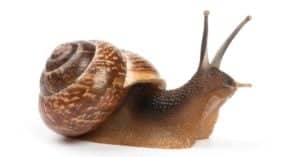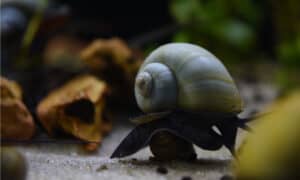You’ve probably wondered at least once in your life what the differences between Trochus snails and Astrea snails are. These are two gorgeous types of snails that saltwater aquarium owners prefer for their tanks. They are peaceful, solitary, and unique tank cleaners.
So, what is the difference between them? How do they look? What do they eat? How do they behave in a tank? How do they reproduce? You’ll find an answer to all these questions in the insightful article we’ve prepared for you!
Comparing Trochus Snails vs Astrea Snails
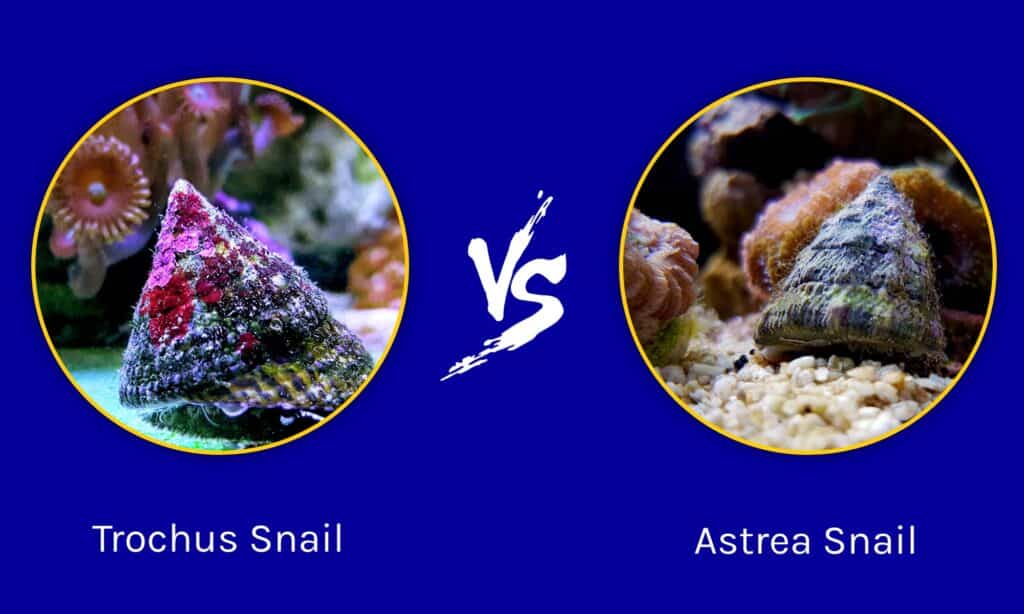
| Trochus Snail | Astrea Snail | |
|---|---|---|
| Technical term | Genus | Genus |
| Size | 1-3 inches | Up to 2.4 inches |
| Colors | Creamy-white, brown, red, purple; shiny shell | Red, orange, creamy-white |
| Diet | Herbivore | Herbivore |
| Lifespan | 2-3 years | Up to 5 years |
The Key Differences Between Trochus Snails and Astrea Snail
The key differences between Trochus snails and Astrea snails are appearance, reproduction, and lifespan.
Trochus snails are a genus of sea snails. They include medium to large top-shaped snails. They are popular among snail enthusiasts because they have a unique appearance and are amazing saltwater aquarium cleaners. Trochus snails are also called top shell snails, black foot trochus, and turban snails.
Just like Trochus snails, Astrea snails are a genus of sea snails in the Turbinidae family. This genus includes medium-sized to large snails. Astrea snails are also preferred by saltwater aquarium owners, as they require little to no care and are great at cleaning their habitat.
Trochus Snail vs Astrea Snail: Color and Form

Astrea snails’ standard colors include reddish-orange with white or olive green spots.
©iStock.com/vojce
Trochus snails can have a variety of colors, but the most common are creamy-white, reddish-brown, purple, green, or brown shades. Research shows that their shell color loses its brightness because it becomes encrusted with algae over time.
The shell of trochus snails is thick and solid and can have up to 10 whorls. Its base is flat. They use their tentacles to detect if there are any chemicals in the water.
Astrea snails’ standard colors include reddish-orange with white or olive green spots.
Their shells are thick and elevated, having a conical form. They feature small spikes in a spiral form that makes the snail look like a star. The shell base is almost flat.
Trochus Snail vs Astrea Snail: Size
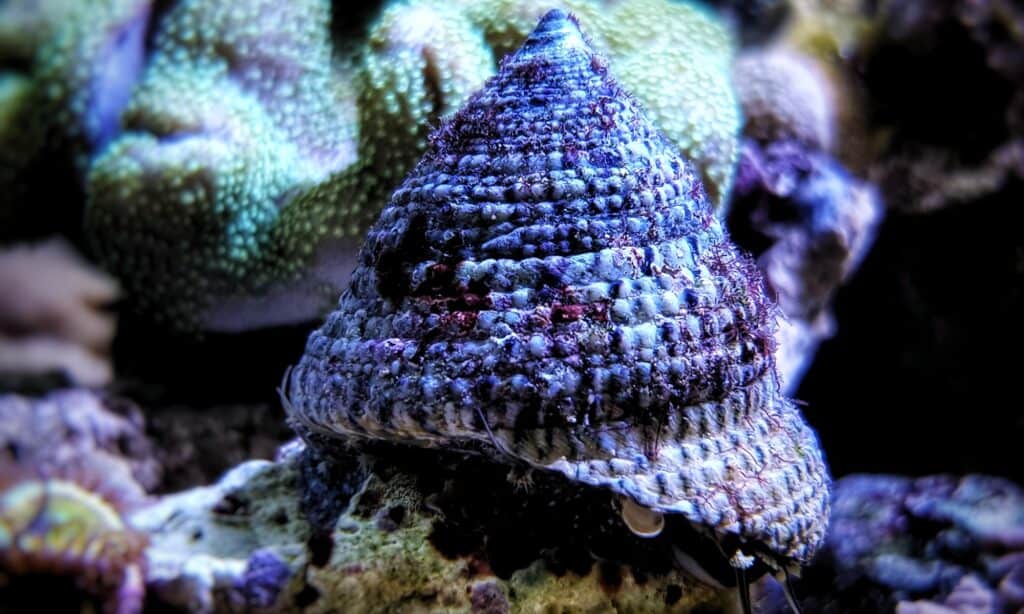
Astrea snails can be as small as 0.4 inches and as large as 2.4 inches.
©iStock.com/vojce
Both species of snails are relatively small, the larger ones measuring 2.4-3 inches. Trochus snails, however, are a bit larger, reaching an impressive size of 3 inches. Not all types of Trochus snails grow as big, though; some of them never get larger than 1 inch.
Astrea snails can be as small as 0.4 inches and as large as 2.4 inches.
Trochus Snail vs Astrea Snail: Reproduction
Trochus snails and Astrea snails have both female and male representatives of the species. Their breeding process, however, differs a bit.
Female trochus snails do not lay eggs; they release millions of them into the water. The male trochus snail releases its semen – this is called spawning, and it makes the water have a milky color for a few hours. Then, the fertilized eggs produce larvae. The larval stage can take up to 3-7 days. Research shows that only a few dozen larvae can survive and reach adulthood.
Astrea snails can reproduce when they reach 6-8 months old. Just like in trochus snails, spawning happens in the water, being initiated by male snails. Female spawning takes 5-10 minutes, releasing around one million unfertilized eggs. In their case, the larval stage is shorter – 3-5 days. Unfortunately, just like it happens with trochus snail eggs, the mortality rate for Astrea snail eggs is very high.
Trochus Snail vs Astrea Snail: Lifespan
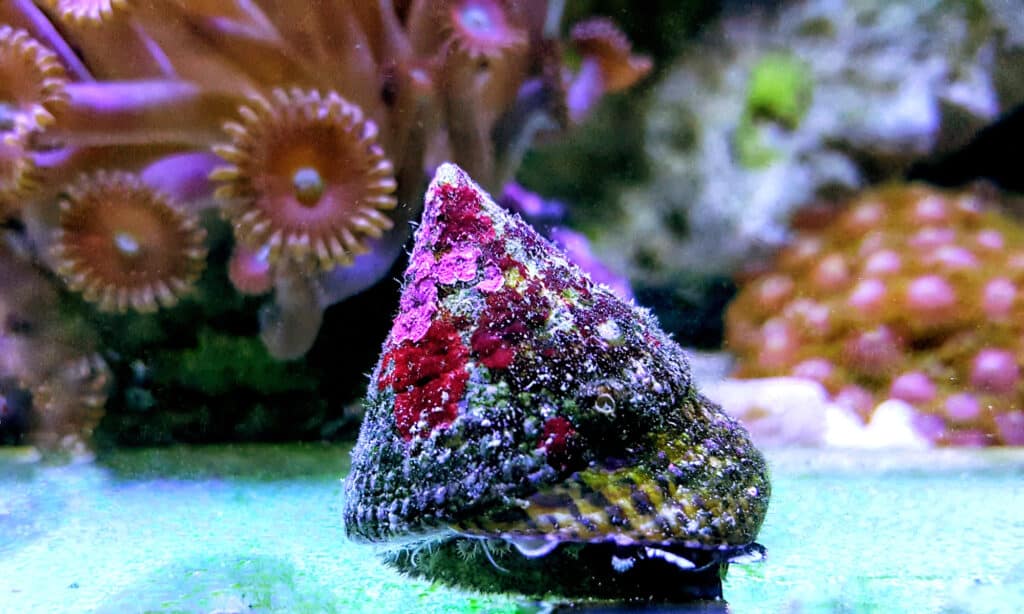
Trochus snails have an average lifespan of 2-3 years.
©Vojce/Shutterstock.com
Astrea snails can live up to 5 years, while trochus snails have an average lifespan of 2-3 years. For your snails to live so long, adjusting the aquarium water and environment according to their needs is essential. If you’re worried that your snail is not feeling alright, its operculum will be of great help. If the snail is sick, the operculum will not close as needed. A small opening points to the fact that there’s something wrong with the snail. If the opening is larger, it means that the snail is very sick or dying.
The Similarities Between Trochus Snails and Astrea Snails
Trochus Snail vs Astrea Snail: Behavior
Trochus snails and Astrea snails are non-aggressive, solitary, nocturnal species. They prefer living in peaceful tank environments because they don’t have any help to attack other tank mates. They are usually active during the night and become sedentary right before sunrise. They’ve developed this behavior because they try to avoid predators seeing them.
Trochus Snail vs Astrea Snail: Diet
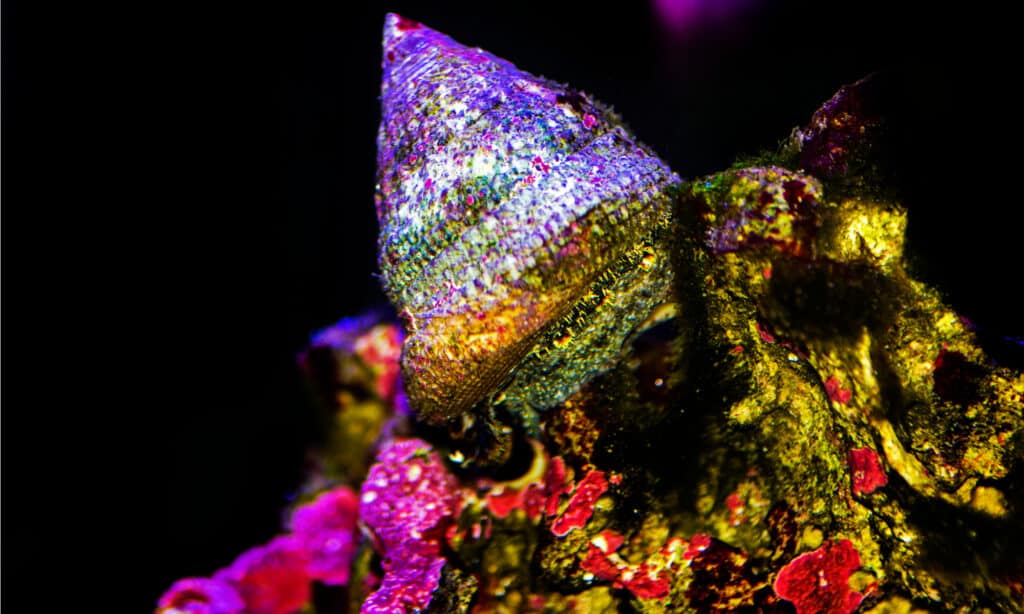
Trochus snails, along with Astrea snails, feed on algae.
©Vojce/Shutterstock.com
If you’re planning to get a Trochus snail or an Astrea snail, you need to know that they like to eat a lot. If you already have one, we’re sure you’ve noticed this! It means you’ll have to clean the tank more often. In any case, they love brown algae, hair algae, green algae, and filamentous algae that can be found on rocks. You’ll likely have to feed them with supplements, including pills, pellets, flakes, algae wafers, or frozen foods.
Trochus Snail vs Astrea Snail: Operculum
Both snails have an operculum. This is a kind of trapdoor used by snails to close the shell entrance while they hibernate in the mud. This happens during dry periods and prevents them from drying out. The operculum is also of great help for snail owners because it points out the snail’s well-being. If there’s something wrong with it, the operculum will not close properly. The bigger the opening, the sicker the snail is. If the snail is dead, the operculum falls off completely.
The photo featured at the top of this post is © Vojce/Shutterstock.com
Thank you for reading! Have some feedback for us? Contact the AZ Animals editorial team.



